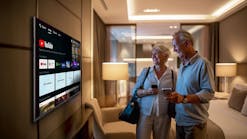Date Announced: 16 Dec 2011 - Energy Saving Trust trial shows LEDs can bring better light brightness, colour, and distribution in social housing communal areas - On-going energy savings of over 3 million kWh per year – - Photos document striking transformation of buildings – LEDs can lighten the gloom in social housing and bring about significant reductions in energy and maintenance costs, according to an Energy Saving Trust field trial of over 4,000 light fittings in England. Management consultants McKinsey recently forecast that LED lighting has the potential to become the dominant technology in domestic and commercial lighting as early as 2015. In 2008 the Energy Saving Trust completed a feasibility study that looked into installing LED lighting in communal areas of social housing, such as stairwells and corridors. The study showed that there was considerable potential for achieving energy savings in such areas, particularly as the lighting is typically on 24 hours per day. Now Lit Up, the Energy Saving Trust’s field trial report of the technologies in action, shows increases in light levels, colour temperature and good maintenance of performance over time, as well as considerable energy and long-term cost savings. The first phase of the trial, which ran in 2008-09, saw a 100 per cent average improvement in light (lux) levels across the sites, with two buildings showing lux improvements of over 500 per cent. The second phase of the trial, in 2009-10, featured a greater number of individual light fittings and also saw an increase in lux levels, of 57 per cent.‘Colour temperature’ was also measured. The existing lighting across the trial had an average colour temperature of 3,344K - close to the typical ‘warm white’ colour typically produced by fluorescent lighting. LEDs are more efficient the whiter or colder the light is, and the average colour temperature across all the sites significantly increased to a much cooler temperature – just over 5086K. This is much closer to that provided by natural daylight.Phase 1 saw average increases of just under 1,700 kelvin (K). In phase 2 the increase was even greater, at just under 1,800K. The cooler, brighter light has greatly enhanced the ambience within most of the sites and coupled with an improvement in colour rendering, has made colours appear much sharper – closer to how they would appear in daylight.On-going energy savings were calculated for both phases of the trial by looking at how much energy would have to be consumed for the existing lighting to reach the light levels achieved by the LEDs - creating a ‘normalised’ comparison.Using this method, the installed LEDs in phase 1 saved over 2,000,000kWh per year, while savings in the second phase were just under 1,300,000kWh per year. Across both phases of the trial, the normalised energy savings from the new LED lighting installed across the field trial - just under 3.4 million kWh per year – is the equivalent to lighting 5,788 average UK homes for a year with traditional lighting. The trial also showed LEDs maintaining their performance over time. Light levels were measured after approximately six months use, showing average maintenance of levels across the two trial phases of 93.6 per cent. Some sites showed no discernable change over the time period at all, while one found increased light levels. The improvements have been documented in a series of digital photographs – which show striking transformations of light levels in communal spaces.James Russill, Technical Development Manager for the Energy Saving Trust, said: “The development of LED lighting represents a major revolution for the lighting sector – promising a major step-change in efficiency. This trial has shown that the technology is performing to a high standard - light levels, colour, and distribution of light have been shown to dramatically improve. In terms of social housing this represents a great opportunity to overhaul the look and feel of the places people live and also reduce costs at the same time.”Using the ‘normalised’ energy savings calculated, the LED lighting in both phases of the trial would pay back its original investment cost in roughly two years – significantly less than the lifetime of the LEDs themselves. At the time the trial began, the lack of ‘off the shelf’ light fittings and the requirement of bespoke fittings for a new installation significantly impacted upon the payback time for installing LED lighting. However, in the course of the study it was clear that this had been rectified by the ongoing rapid development of LED technology. There are now numerous companies in the UK who are now manufacturing ‘off the shelf’ fittings, suitable for installation as direct retrofits in communal and domestic environments. The variety and efficiency of products available increased throughout the duration of the trial and continues to do so today. Russill adds: “The final issue to overcome in getting LED lighting in more buildings is cost. It’s a fact of life that when technologies are new to market the cost tends to be quite high and reduce as they become more mass-market. This is happening, and what’s more, we hope that this trial will go a long way to convince housing providers that the investment is more than worth it in terms of energy savings and reduced maintenance costs over the long life of LED fittings.“It should also be noted that although this trial clearly shows that LEDs are a success story for social housing, the fact is that good quality LED light fittings are available for many different uses in both domestic, social housing and commercial buildings.”The trial’s installations have also received a favourable response from housing providers.Mike Walsh from New Charter Housing Trust said: “The lighting has made a major transformation at all three sites, the results are fantastic. Staff and residents at all sites have made favourable comments on the improvements.” Vince Ward, Southern Housing Group, said: “Tenants are very happy with lighting especially in the knowledge that they are cheaper to run which will reflect in their service charge.”David Wilkinson from Flagship Housing said: “Fantastic - everyone's happy, staff and residents! We will be internally decorating the scheme shortly to compliment the new fittings as the new level of light actually shows the true colours of the walls.” On the back of the study, the Energy Saving Trust is planning to begin discussions with government and industry about ways that the market for LEDs could be supported in coming years. The Trust are also looking to endorse a larger range of LED products under the Energy Saving Trust Recommended labelling scheme over the coming months.
Contact
020 7227 0398
E-mail:[email protected]
Web Site:www.energysavingtrust.org.uk/Publications2/Energy-efficiency/Lit-Up-an-LED-lighting-field-trial




